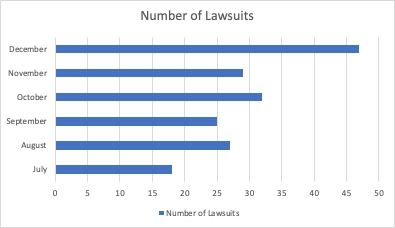WCAG Auditing And Remediation Short-Cuts To Avoid
There are a growing number of “overlay” solution providers who claim to be able to make any website WCAG compliant simply by adding a plugin or JavaScript snippet.
Over 600 Accessibility professionals and disability rights groups have co-signed the Overlay Fact-Sheet outlining why accessibility overlays such as the following are unnecessary and may impede the intended goals. AccessiBe, Accessiblelink, Accessiway, Adally, Adapte Mon Web (Adapt my Web), Allyable, AudioEye, EqualWeb, FACIL’iti, Lisio, MaxAccess, MK-Sense, ReciteME, Sogo, TruAbilities, True Accessibility, UsableNet Assistive, User1st, UserWay, Purple Lens amongst others.
According to Attorney Richard Hunt of Hunt Huey PLLC, in 2020, there were five lawsuits filed in only two weeks regarding businesses with an inaccessible website that used an accessibility overlay or widget.
To make matters even scarier, throughout the entire year of 2020, there were a total of 250 lawsuits filed for companies that used overlay accessibility solutions.

Only about 30% of problems are detected using automated solutions. The phrase “overlay” implies that these methods do not repair the underlying code. They also need to be activated by the user manually.
Overlays create a negative user experience that alienates this part of your audience and puts your company at risk of brand damage and revenue loss. By utilizing overlays, you are essentially providing people with disabilities with a different online experience that has less functionality, which is in direct opposition to the goals of digital inclusion.
Creating an inclusive web environment necessitates fixing any accessibility concerns on your primary site so that you can provide one unified brand experience for all users.
There is no alternative when it comes to making your website accessible to actual people with disabilities. WCAG 2.1 A and AA audits, which are conducted by an expert accessibility consultant who understands both WCAG and programming code, are required for true ADA compliance.
EcomBack has ADA consultants that can provide the best WCAG ADA Website Compliance services.
What Are Overlay Accessibility Solutions?
Overlay solutions are automated software solutions that essentially add a layer over the site that addresses a small fraction of accessibility complications. They basically “fix” the easy stuff but leave out a lot of necessary components, which means it is virtually impossible to claim actual WCAG compliance for ADA requirements this way.
These quick solutions are typically depicted as an “accessibility button” that a disabled visitor needs to be able to find and open (which may not even be possible for some users).
- The button opens a toolbar with options such as text adjustments (size, spacing, alignment), color (contrast, saturation, monochrome), adjusts curser, adds focus states, magnifies, and a screen reader (sometimes provided).A couple of accessibility buttons incorporate Artificial Intelligence to interpret images and automatically add alternative tags that describe images. However, accuracy and usefulness for the actual person using a screen reader are low.
What issues are ignored by accessibility overlay tools?
Absence of headings or headings that aren’t properly coded
Missing alt text on images
Link text marked clearly
No labels on form fields
Required form fields not indicated
Lack of submit button

Most of these issues are huge barriers to web users with disabilities.
Why Overlay Solutions Fail to Deliver True ADA Accessibility
Those that refer to overlays as “band-aids” are correct. In fact, they’re band-aids that fail to cover the middle of the wound. They just cover the edges.
Overlays miss 70% of WCAG issues and can only be assessed using manual testing. By default, the inaccessible underlying code is fully exposed to legal trolls. While some providers claim to provide manual testing and remediation, it is only applied to the overlay layer, not the underlying code.
Additionally, overlay tools have a negative impact on the performance of your website. Because overlays are often hosted on a third-party vendor’s server, you have no control over if the overlay script is too slow to load.
When you combine all these issues together, it’s easy to see why we don’t recommend any overlay solutions. Even custom overlay solutions lack flexibility and can break during basic site maintenance. One minor change on your site has the potential to disrupt the entire overlay.

Any person with a disability already has their favorite set of tools and browser settings. The most significant and unfortunate truth about overlay solutions is that they force a disabled user to study, learn, and customize this new set of toolbar options for each website they visit.
So, in reality, they don’t work for the actual people with disabilities behind the screen. They only work in the interests of website owners who want to avoid the expenses associated with proper web accessibility.
Lastly, people with disabilities will have a hard time using websites on their mobile devices to browse websites unless heavy customization is applied since any out-of-the-box solution will very likely fail for mobile users.
The Website Code & Violations Are Legally Exposed with Overlays
Overlay Solutions Lack Manual Testing and Remediation
Accessibility Overlays Hinder Website Performance
Overlays Override the Users’ Existing Assistive Tools
Accessibility Overlays Don’t Work for Mobile
Overlays Open Security Holes
EcomBack Has Premium ADA Compliant Website Services
EcomBack has a 7-point plan to address the issues on your website with the aim to defend the current claim and avoid future lawsuits.
After meeting with your business and discussing the right ADA compliance strategy, our expert team of ADA consultants then begins with a comprehensive audit to review the urgent errors, alerts, color contrast, media, video captions, ARIA, page flow, and other requirements to make your website accessible for people with disabilities.
We also provide an Accessibility Statement and ADA training for your business.
